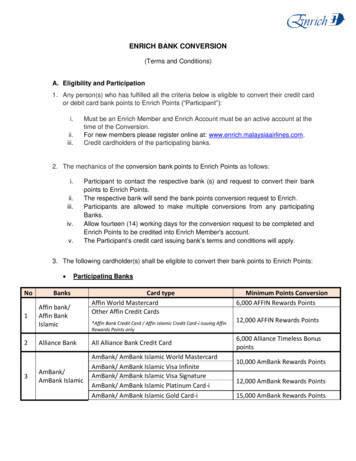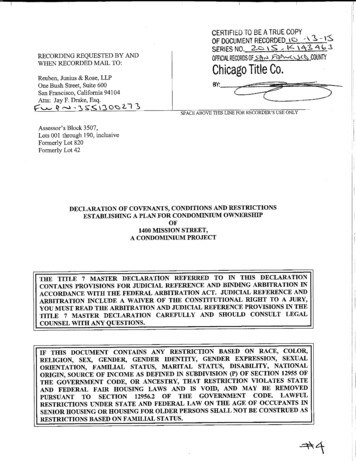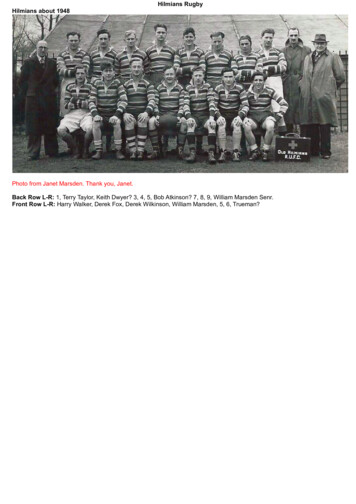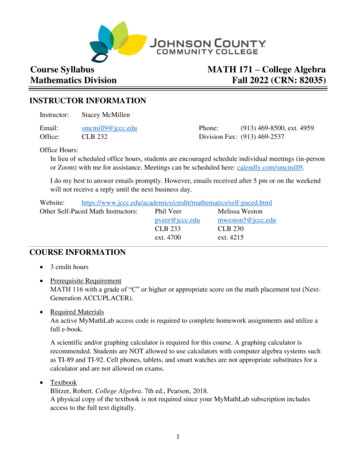
Transcription
Section 5.3 Points on Circles Using Sine and Cosine 321Section 5.3 Points on Circles Using Sine and CosineWhile it is convenient to describe the location of a point on a circle using an angle or adistance along the circle, relating this information to the x and y coordinates and the circleequation we explored in Section 5.1 is an important application of trigonometry.A distress signal is sent from a sailboat during a storm, but the transmission is unclearand the rescue boat sitting at the marina cannot determine the sailboat’s location. Usinghigh powered radar, they determine the distress signal is coming from a distance of 20miles at an angle of 225 degrees from the marina. How many miles east/west andnorth/south of the rescue boat is the stranded sailboat?In a general sense, to investigate this, we begin bydrawing a circle centered at the origin with radius r,and marking the point on the circle indicated by someangle θ. This point has coordinates (x, y).(x, y)rθIf we drop a line segment vertically down from thispoint to the x axis, we would form a right triangleinside of the circle.No matter which quadrant our angle θ puts us in wecan draw a triangle by dropping a perpendicular linesegment to the x axis, keeping in mind that the valuesof x and y may be positive or negative, depending on the quadrant.Additionally, if the angle θ puts us on an axis, we simply measure the radius as the x or ywith the other value being 0, again ensuring we have appropriate signs on the coordinatesbased on the quadrant.Triangles obtained from different radii will all be similar triangles, meaningcorresponding sides scale proportionally. While the lengths of the sides may change, theratios of the side lengths will always remain constant for any given angle.To be able to refer to these ratios more easily, we will give them names. Since the ratiosdepend on the angle, we will write them as functions of the angle θ .Sine and CosineFor the point (x, y) on a circle of radius r at an angle of θ , wecan define two important functions as the ratios of the sides ofthe corresponding triangle:yThe sine function: sin(θ ) rxThe cosine function: cos(θ ) r(x, y)rθxy
322 Chapter 5In this chapter, we will explore these functions using both circles and right triangles. Inthe next chapter we will take a closer look at the behavior and characteristics of the sineand cosine functions.Example 1The point (3, 4) is on the circle of radius 5 at some angle θ. Find cos(θ ) and sin(θ ) .Knowing the radius of the circle and coordinates of the point, we can evaluate thecosine and sine functions as the ratio of the sides.x 3y 4cos(θ ) sin(θ ) r 5r 5There are a few cosine and sine values which we can determine fairly easily because thecorresponding point on the circle falls on the x or y axis.Example 2Find cos(90 ) and sin(90 )On any circle, the terminal side of a 90 degree anglepoints straight up, so the coordinates of thecorresponding point on the circle would be (0, r).Using our definitions of cosine and sine,x 0cos(90 ) 0r ry rsin(90 ) 1r r(0, r)r90 Try it Now1. Find cosine and sine of the angle π .Notice that the definitions above can also be stated as:Coordinates of the Point on a Circle at a Given AngleOn a circle of radius r at an angle of θ , we can find the coordinates of the point (x, y)at that angle usingx r cos(θ )y r sin(θ )On a unit circle, a circle with radius 1, x cos(θ ) and y sin(θ ) .
Section 5.3 Points on Circles Using Sine and Cosine 323Utilizing the basic equation for a circle centered at the origin, x 2 y 2 r 2 , combinedwith the relationships above, we can establish a new identity.substituting the relations above,x2 y2 r 2222simplifying,(r cos(θ )) (r sin(θ )) r22222dividing by r 2r (cos(θ )) r (sin(θ )) ror using shorthand notation(cos(θ )) 2 (sin(θ )) 2 1cos 2 (θ ) sin 2 (θ ) 1Here cos 2 (θ ) is a commonly used shorthand notation for (cos(θ )) 2 . Be aware that manycalculators and computers do not understand the shorthand notation.In Section 5.1 we related the Pythagorean Theorem a 2 b 2 c 2 to the basic equation ofa circle x 2 y 2 r 2 , which we have now used to arrive at the Pythagorean Identity.Pythagorean IdentityThe Pythagorean Identity. For any angle θ, cos 2 (θ ) sin 2 (θ ) 1 .One use of this identity is that it helps us to find a cosine value of an angle if we knowthe sine value of that angle or vice versa. However, since the equation will yield twopossible values, we will need to utilize additional knowledge of the angle to help us findthe desired value.Example 3If sin(θ ) 3and θ is in the second quadrant, find cos(θ ) .7Substituting the known value for sine into the Pythagorean identity,2 3 cos (θ ) 1 7 9 1cos 2 (θ ) 4940cos 2 (θ ) 4940402 10cos(θ ) 4977Since the angle is in the second quadrant, we know the x value of the point would benegative, so the cosine value should also be negative. Using this additional information,2 10we can conclude that cos(θ ) .72
324 Chapter 5Values for Sine and CosineAt this point, you may have noticed that we haven’t found any cosine or sine values fromangles not on an axis. To do this, we will need to utilize our knowledge of triangles.First, consider a point on a circle at an angle of 45 degrees, orπ.(x, y) (x, x)4At this angle, the x and y coordinates of the corresponding point1on the circle will be equal because 45 degrees divides the firstyquadrant in half. Since the x and y values will be the same, the45 sine and cosine values will also be equal. Utilizing thexPythagorean Identity, π π since the sine and cosine are equal, we cancos 2 sin 2 1 4 4 substitute sine with cosineππ add like termscos 2 cos 2 1 4 4 π divide2 cos 2 1 4 π 1since the x value is positive, we’ll keep the positive rootcos 2 4 2 π cos 4 12often this value is written with a rationalized denominatorRemember, to rationalize the denominator we multiply by a term equivalent to 1 to getrid of the radical in the denominator.1 222 π cos 2 242 4 2 π Since the sine and cosine are equal, sin as well.2 4 The (x, y) coordinates for a point on a circle of radius 1 at an angle of 45 degrees are 2 2 2 , 2 .
Section 5.3 Points on Circles Using Sine and Cosine 325Example 4Find the coordinates of the point on a circle of radius 6 at an angle ofπ4.22 π π Using our new knowledge that sin and cos , along with our22 4 4 relationships that stated x r cos(θ ) and y r sin(θ ) , we can find the coordinates ofthe point desired: 2 π 3 2x 6 cos 6 2 4 2 π 3 2y 6 sin 6 2 4 Try it Now2. Find the coordinates of the point on a circle of radius 3 at an angle of 90 .Next, we will find the cosine and sine at an angle of30 degrees, orπ. To do this, we will first draw a6triangle inside a circle with one side at an angle of 30degrees, and another at an angle of -30 degrees. If theresulting two right triangles are combined into onelarge triangle, notice that all three angles of this largertriangle will be 60 degrees.r60 r60 (x, y)r30 y60 ySince all the angles are equal, the sides will all be equal as well. The vertical line hasrlength 2y, and since the sides are all equal we can conclude that 2y r, or y . Using2this, we can find the sine value:rr 1 1 π ysin 2 2 r 2r 6 r
326 Chapter 5Using the Pythagorean Identity, we can find the cosine value: π π cos 2 sin 2 1 6 6 2 π 1 cos 1 6 2 π 3cos 2 6 42since the y value is positive, we’ll keep the positive root33 π cos 42 6 The (x, y) coordinates for the point on a circle of radius 1 at an angle of 30 degrees are 3 1 2 ,2 . By drawing a the triangle inside the unit circle with a 30 degree angle and reflecting itover the line y x, we can find the cosine and sine for 60 degrees, oradditional work.12y x11230 3232 30 1π3, without anyy x60 By this symmetry, we can see the coordinates of the point on the unit circle at an angle of 1 3 , giving60 degrees will be , 2 2 π 1cos 3 2and3 π sin 3 2We have now found the cosine and sine values for all of the commonly encounteredangles in the first quadrant of the unit circle.Angle0ππππ, or 30 , or 45 , or 60 , or 90 6423Cosine10132222Sine01123222
Section 5.3 Points on Circles Using Sine and Cosine 327For any given angle in the first quadrant, there will be an angle in another quadrant withthe same sine value, and yet another angle in yet another quadrant with the same cosinevalue. Since the sine value is the y coordinate on the unit circle, the other angle with thesame sine will share the same y value, but have the opposite x value. Likewise, the anglewith the same cosine will share the same x value, but have the opposite y value.As shown here, angle α has the same sine value as angle θ; the cosine values would beopposites. The angle β has the same cosine value as the angle; the sine values would beopposites.sin(θ ) sin(α ) and cos(θ ) cos(α )sin(θ ) sin( β ) and cos(θ ) cos( β )(x, y)(x, y)αrrθθβIt is important to notice the relationship between the angles. If, from the angle, youmeasured the smallest angle to the horizontal axis, all would have the same measure inabsolute value. We say that all these angles have a reference angle of θ.Reference AngleAn angle’s reference angle is the size of thesmallest angle to the horizontal axis.(x, y)A reference angle is always an angle between 0and 90 degrees, or 0 andπ2radians.Angles share the same cosine and sine values astheir reference angles, except for signs (positive ornegative) which can be determined from thequadrant of the angle.θθθθ
328 Chapter 5Example 5Find the reference angle of 150 degrees. Use it to find cos(150 ) and sin(150 ) .150 degrees is located in the second quadrant. It is 30 degrees short of the horizontalaxis at 180 degrees, so the reference angle is 30 degrees.This tells us that 150 degrees has the same sine and cosine values as 30 degrees, except31for sign. We know that sin(30 ) and cos(30 ) . Since 150 degrees is in the22second quadrant, the x coordinate of the point on the circle would be negative, so thecosine value will be negative. The y coordinate is positive, so the sine value will bepositive.31sin(150 ) and cos(150 ) 22 3 1 The (x, y) coordinates for the point on a unit circle at an angle of 150 are , .22 Using symmetry and reference angles, we can fill in cosine and sine values at the rest ofthe special angles on the unit circle. Take time to learn the (x, y) coordinates of all of themajor angles in the first quadrant!2π 13 120 ,, , 3 2 2 135 ,150 ,90 ,π2, ( 0, 1)60 ,π 13π 22 , , 4 22 3 , , 3 2 2 45 ,π 4 25π 3 1 , , 6 2 2 30 ,,2 2 π 3 1 , , 6 2 2 0 , 0, (1, 0 )180 , π , ( 1, 0 ) 31 210 ,, , 6 22 5π 22 225 ,, , 4 22 4π 13 240 ,, , 3 22 2, 360 , 2π , (1, 0 )7π330 ,315 ,270 ,3π2, ( 0, 1)300 ,5π3 1, 2, 7π46 2, 23 211π 31 , 2 2, , 2 2
Section 5.3 Points on Circles Using Sine and Cosine 329Example 6Find the coordinates of the point on a circle of radius 12 at an angle of7π.6Note that this angle is in the third quadrant, where both x and y are negative. Keepingthis in mind can help you check your signs of the sine and cosine function. 3 7π 6 3x 12 cos 12 2 6 1 7π y 12 sin 12 6 2 6 The coordinates of the point are ( 6 3 , 6) .Try it Now3. Find the coordinates of the point on a circle of radius 5 at an angle of5π.3Example 7We now have the tools to return to the sailboat question posed at the beginning of thissection.A distress signal is sent from a sailboat during astorm, but the transmission is unclear and the rescueboat sitting at the marina cannot determine thesailboat’s location. Using high powered radar, theydetermine the distress signal is coming from adistance of 20 miles at an angle of 225 degrees fromthe marina. How many miles east/west andnorth/south of the rescue boat is the stranded sailboat?We can now answer the question by finding thecoordinates of the point on a circle with a radius of 20miles at an angle of 225 degrees. 2 14.142 milesx 20 cos(225 ) 20 2 2 14.142 milesy 20 sin (225 ) 20 2 N225 W20 miSThe sailboat is located 14.142 miles west and 14.142 miles south of the marina.E
330 Chapter 5The special values of sine and cosine in the first quadrant are very useful to know, sinceknowing them allows you to quickly evaluate the sine and cosine of very common angleswithout needing to look at a reference or use your calculator. However, scenarios docome up where we need to know the sine and cosine of other angles.To find the cosine and sine of any other angle, we turn to a computer or calculator. Beaware: most calculators can be set into “degree” or “radian” mode, which tells thecalculator the units for the input value. When you evaluate “cos(30)” on your calculator,it will evaluate it as the cosine of 30 degrees if the calculator is in degree mode, or thecosine of 30 radians if the calculator is in radian mode. Most computer software withcosine and sine functions only operates in radian mode.Example 8Evaluate the cosine of 20 degrees using a calculator or computer.On a calculator that can be put in degree mode, you can evaluate this directly to beapproximately 0.939693.On a computer or calculator without degree mode, you would first need to convert theπ angle to radians, or equivalently evaluate the expression cos 20 .180 Important Topics of This SectionThe sine functionThe cosine functionPythagorean IdentityUnit Circle valuesReference anglesUsing technology to find points on a circleTry it Now Answers1. cos(π ) 1 sin(π ) 0 π x 3 cos 3 0 0 2 2. π y 3 sin 3 1 3 2 5 5 3 3. ,2 2
Section 5.3 Points on Circles Using Sine and Cosine 331Section 5.3 Exercises1. Find the quadrant in which the terminal point determined by t lies ifa. sin(t ) 0 and cos(t ) 0b. sin(t ) 0 and cos(t ) 02. Find the quadrant in which the terminal point determined by t lies ifa. sin(t ) 0 and cos(t ) 0b. sin(t ) 0 and cos(t ) 03. The point P is on the unit circle. If the y-coordinate of P isfind the x coordinate.4. The point P is on the unit circle. If the x-coordinate of P isIV, find the y coordinate.3, and P is in quadrant II,51, and P is in quadrant51and θ is in the 4th quadrant, find sin (θ ) .726. If cos (θ ) and θ is in the 1st quadrant, find sin (θ ) .937. If sin (θ ) and θ is in the 2nd quadrant, find cos (θ ) .818. If sin (θ ) and θ is in the 3rd quadrant, find cos (θ ) .45. If cos (θ ) 9. For each of the following angles, find the reference angle and which quadrant theangle lies in. Then compute sine and cosine of the angle.a. 225 b. 300 c. 135 d. 210 10. For each of the following angles, find the reference angle and which quadrant theangle lies in. Then compute sine and cosine of the angle.a. 120 b. 315 c. 250 d. 150 11. For each of the following angles, find the reference angle and which quadrant theangle lies in. Then compute sine and cosine of the angle.5π5π3π7πa.b.c.d.434612. For each of the following angles, find the reference angle and which quadrant theangle lies in. Then compute sine and cosine of the angle.4π2π5π7πa.b.c.d.3364
332 Chapter 513. Give exact values for sin (θ ) and cos (θ ) for each of these angles.a. 3π4b.23π6c. πd. 5π214. Give exact values for sin (θ ) and cos (θ ) for each of these angles.a. 2π3b.17π4c. π6d. 10π15. Find an angle θ with 0 θ 360 or 0 θ 2π that has the same sine value as:4ππb. 80 c. 140 d.e. 305 a.3316. Find an angle θ with 0 θ 360 or 0 θ 2π that has the same sine value as:7ππb. 15 c. 160 d.e. 340 a.6417. Find an angle θ with 0 θ 360 or 0 θ 2π that has the same cosine value as:π4πa.b. 80 c. 140 d.e. 305 3318. Find an angle θ with 0 θ 360 or 0 θ 2π that has the same cosine value as:π7πa.b. 15 c. 160 d.e. 340 6419. Find the coordinates of the point on a circle with radius 15 corresponding to an angleof 220 .20. Find the coordinates of the point on a circle with radius 20 corresponding to an angleof 280 .21. Marla is running clockwise around a circular track. She runs at a constant speed of 3meters per second. She takes 46 seconds to complete one lap of the track. From herstarting point, it takes her 12 seconds to reach the northernmost point of the track. Imposea coordinate system with the center of the track at the origin, and the northernmost pointon the positive y-axis. [UW]a) Give Marla’s coordinates at her starting point.b) Give Marla’s coordinates when she has been running for 10 seconds.c) Give Marla’s coordinates when she has been running for 901.3 seconds.
corresponding point on the circle falls on the x or y axis. Example 2 Find . cos(90 ) and sin(90 ) On any circle, the terminal side of a 90 degree angle points straight up, so the coordinates of the corresponding point on the circle would be (0, r). Using our definitions of cosine and sine, 0 0 cos(90 ) r r x sin(90 ) 1 r r r y .











